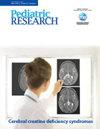基因组医学时代的早期干预服务:制定研究议程。
IF 3.1
3区 医学
Q1 PEDIATRICS
引用次数: 0
摘要
新生儿基因组测序(NBSeq)有可能大大改善罕见遗传病的早期检测,从而进行症状前治疗,优化治疗效果。对 NBSeq 临床效用的扩展概念包括更早地获得行为早期干预,以支持在早期发育的关键窗口期获得核心运动、认知、沟通和适应技能。然而,对于越来越多通过 NBSeq 鉴定出患有遗传疾病的婴儿来说,如何公平地获得早期干预项目的服务仍是一个重要问题。我们回顾了当前 NBSeq 的公共卫生、临床和研究情况,并重点介绍了国际上正在开展的研究工作,以收集有关 NBSeq 对健康新生儿的效用的人群级数据。然后,我们探讨了特定的早期干预(EI)系统--美国联邦政府支持的 "C 部分 "系统--在满足遗传诊断幼儿的发展需求方面所面临的挑战,包括与资金、不同的资格标准以及与新生儿筛查项目缺乏合作有关的结构性限制。最后,我们提出了一系列问题,以指导未来在 NBSeq、新生儿筛查和幼儿教育交叉领域的研究,这些问题一旦得到解答,就能引导未来的政策,确保幼儿教育服务系统能为受到更广泛实施 NBSeq 影响的婴儿的发育需求提供最佳支持。影响:关于新生儿基因组测序临床益处的现有文献往往侧重于早期提供医疗干预,而较少关注患有遗传病的年幼儿童的持续发展需求。本综述概述了越来越多的婴儿期遗传病患儿的发展需求,并介绍了美国早期干预系统(IDEA C 部分)在满足这些需求方面的优势和局限性。本文章由计算机程序翻译,如有差异,请以英文原文为准。

Early Intervention services in the era of genomic medicine: setting a research agenda
Newborn genomic sequencing (NBSeq) has the potential to substantially improve early detection of rare genetic conditions, allowing for pre-symptomatic treatment to optimize outcomes. Expanding conceptions of the clinical utility of NBSeq include earlier access to behavioral early intervention to support the acquisition of core motor, cognitive, communication, and adaptive skills during critical windows in early development. However, important questions remain about equitable access to early intervention programs for the growing number of infants identified with a genetic condition via NBSeq. We review the current NBSeq public health, clinical, and research landscape, and highlight ongoing international research efforts to collect population-level data on the utility of NBSeq for healthy newborns. We then explore the challenges facing a specific Early Intervention (EI) system—the US federally supported “Part C” system—for meeting the developmental needs of young children with genetic diagnoses, including structural limitations related to funding, variable eligibility criteria, and lack of collaboration with newborn screening programs. We conclude with a set of questions to guide future research at the intersection of NBSeq, newborn screening, and EI, which once answered, can steer future policy to ensure that EI service systems can optimally support the developmental needs of infants impacted by broader implementation of NBSeq.
求助全文
通过发布文献求助,成功后即可免费获取论文全文。
去求助
来源期刊

Pediatric Research
医学-小儿科
CiteScore
6.80
自引率
5.60%
发文量
473
审稿时长
3-8 weeks
期刊介绍:
Pediatric Research publishes original papers, invited reviews, and commentaries on the etiologies of children''s diseases and
disorders of development, extending from molecular biology to epidemiology. Use of model organisms and in vitro techniques
relevant to developmental biology and medicine are acceptable, as are translational human studies
 求助内容:
求助内容: 应助结果提醒方式:
应助结果提醒方式:


